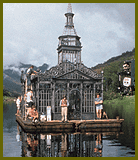An eccentric romance sets afloat an improbable adventure OSCAR AND LUCINDA, a lush period drama directed by Gillian Armstrong and photographed by Geoffrey Simpson, ACS.
Even for the Land Down Under, it was an amazing scene: a huge glass church, mounted on a wooden barge, wending its way down the Mann River in Jackadgery, Australia, surrounded by hooded men and women wearing dark robes. "It was my own little Fitzcarraldo," Australian director Gillian Armstrong says with a laugh. The reference, of course, is to Werner Herzog's infamous tale of obsession, in which a massive boat is hauled over a South American mountain.
Armstrong (My Brilliant Career, Mrs. Soffel) had wanted to adapt Peter Carey's epic novel Oscar and Lucinda when she read it in galley form more than a decade ago. The story concerns a pair of inveterate gamblers: a wayward seminarian (Ralph Fiennes) who can't resist a bet, and an ambitious but impractical businesswoman (Cate Blanchett) whose dream is to buy a glassworks factory. The pair's lives eventually converge in an unlikely but touching romance that leads them to an epic expression of religious conviction.
The success of Armstrong's 1994 film version of Louisa May Alcott's Little Women finally gave her the freedom to tackle this ambitious art-house project, but translating Carey's dark tale demanded a different kind of religious fervor and a lot of guts. Oscar and Lucinda is certainly not the most commercial step Armstrong could have taken after Little Women. "There were many who advised me not to do it, which I considered madness," the feisty Armstrong states. Like her titular characters (played with gusto by Fiennes and newcomer Blanchett), she gambled everything to bring her vision to the screen. "There's a reason you stick with a story and gather together a whole group of people who love it for the same reasons despite the hazards, the floods, the thunder and the lightning."
Indeed, the gods seemed to be fighting the project every step of the way, turning the production of Oscar and Lucinda into an epic story of its own. Carey's unusual tale compelled top craftspeople in the Australian film industry to join Armstrong on her quest. Topping this list were director of photography Geoffrey Simpson, ASC; production designer Luciana Arrighi and costume designer Janet Patterson.
Simpson, riding high on the success of Shine [see AC April '96] and Little Women, resisted offers from American filmmakers in order to join Armstrong in Australia. The duo had also previously worked together on The Last Days of Chez Nous, and both were eager to test the boundaries of period filmmaking. "We wanted Oscar and Lucinda to have a boldness, a strength of both composition and color, because it's not a pretty period film," Armstrong asserts. "We were very conscious of making it quite crisp and bold, and keeping the blacks very black."
That crispness can be seen in every image, thanks to a certain cold blue cast to the light, which imparts a steeliness to even the warmer scenes. Simpson relates, "It was certainly a huge departure from Little Women, which was a more classic-looking period film with a really warm lamp-lit look all the way through. On this one, Gill wanted to go away from that direction and try for a bolder, more contemporary-looking film with a sort of industrial, gutsy edge. We had discussions early on, sitting around a large table with heaps of reference books, throwing ideas, photographs and different painters into the pot."
Oscar and Lucinda's first scenes were shot on a barren beach in Cornwall, England, where the infant Oscar chases after his puritanical father, who charges into the sea as he grieves over his wife's death. Thanks to Simpson's imaginative camerawork, the sand appears as a stunning combination of china white with damp patches of chilly pastel blue. "The ideal would have been to shoot in early morning light," Simpson says. "Actually, there's quite a story behind that. We surveyed this deserted beach three months earlier, but when we came back to shoot, England was in the midst of an extended Indian summer, and the beach was just filled with people! The place was packed with surfers and beach balls, and here we were looking for the lonely Cornwall beach. The first assistant director said, 'Guys, you're having me on you want me to clear the beach?' We had to enlist lifeguards as assistant directors, but by the time the beach was emptied two hours later, it had actually turned bright and sunny."
So much for early-morning light. "We used an 81EF or an 81A filter just to cool the sun down slightly," Simpson says. "I wanted to keep a fairly solid, consistent negative; I knew we'd be shooting the scene throughout the entire day, where the light was going to be normal day-color temperature. I didn't want to go too far with the negative in case we got caught with matching stuff later on. I knew there would be an opportunity to time in more blue in the lab. I wasn't able to be on hand for most of the timing, but Gill did a lot of work with Arthur Cambridge, the timer at the lab in Sydney. He did Shine and all of the other films I've done, as well as many for John Seale [ASC, ACS] and Don McAlpine [ASC, ACS]. In fact, Arthur recently received a Lifetime Achievement Award from the ACS. He and Gill went through the film, which was just a one-light workprint; the blue had a lot to do with Arthur really pushing it. As John Seale says, 'Thank God for Kodak and Arthur Cambridge.'"
[ continued on page 2 ]
